This is the ultimate list of sensory diet activities for kids. Many ideas can be done with common household items and are easy to use and put into your routine!
I’ve been wanting to write this post for a while now.
It’s a big one, filled to the brim with sensory diet activities you can use for your child or toddler. Heck, many of these ideas work for adults, too.
No matter what your age, the following list will be a great jumping off point for creating a sensory diet or for adding some new activities into the mix.
But there are a couple of guidelines that are incredibly important to follow whenever you use any sensory activity with your child…
Guidelines for Sensory Diet Activity
1. Never ever ever force your child to do any sensory diet activity. Sensory activities aren’t homework or medicine, and they work best when a child is motivated to participate in them.
It’s really important to keep in mind that in many cases, kids may be refusing a sensory activity because it is overwhelming to their unique sensory system, even if it isn’t to yours. The finger paints that you may think aren’t so bad to touch, can actually be perceived as painful to your child.
That’s not to say that you can’t demonstrate, model, and encourage. That’s what we OT’s do, we want to push kids out of their comfort zone just a little and follow THEIR lead as much as possible.
Experiencing new sensory input can have wonderful effects on their development, but when we force them to do so, it’s almost a guarantee that it will backfire.
2. This list is meant to inspire, not overwhelm. If you’re just getting your feet wet with sensory diets, then take it slow and just pick a few activities that seem really manageable.
Try them a few times and see if your child has a positive response. I have focused on keeping these activities simple, with little or no set-up.
3. Your child’s sensory needs may change from day to day or even hour to hour, remember that just because a particular activity or strategy didn’t work on this list today, doesn’t mean it won’t tomorrow.
The idea is to have a toolbox full of sensory activities that you can pull from as you need to. However, not all activities will benefit your child. There will be some they don’t like or seem interested in, ever. That’s fine.
If you aren’t quite sure what a sensory diet is or if your child needs one, then check out This post on how to create a sensory diet just for your child.
It comes with a free printable sensory diet template and you’ll be able to hone in on those beneficial activities even better.
Understanding what they are, and who they’re for, will help you create a sensory diet that is easy to manage and that really makes a difference in your kid’s life.
And, if you’re concerned your child with sensory “issues” needs more help, then head over to sensory integration therapy to find out!
Affiliate links used below. See our full disclosure.
Sensory Diet Activities
You will find that all of the activities are organized into different groups, please note that there is some crossover, and duplications, as appropriate.
Many of these activities give sensory input to several senses. While there are categories listed (calming, alerting, etc.), please note that these are generalizations. It is possible your child could have a different response, as everyone’s sensory system is unique.
Again, make sure you watch how your child responds during and after the activity:
- Do they seem calmer?
- More attentive?
- Focused?
- Are they sleeping better? (Check out sensory tips for sleeping)
- Or eating better?
- Are they interacting and communicating more with others?
- Did they follow directions more easily?
- Were they able to learn something quicker?
Making these observations will help you determine how they are responding to a particular sensory diet activity, and when you should use that activity or one similar to it again!
And, you can snag my custom set of sensory diet cards, that include the most powerful and versatile sensory diet activities, for yourself!
*Get a seat in the free 3 Expert Secrets to Calm and Focus Your Kid with Sensory Activities. What you learn can change everything, you’ll get a free workbook and checklist too!*
Sensory Activities That Improve Attention, Focus, & Engagement
Below, you will find many of the activities include a link to a DIY tutorial or an affiliate link, as some of these tools might be new to you. Everything on this list are sensory tools and toys that I love and use.
(Often called organizing activities because they typically allow kid’s sensory systems to become more balanced which leads to improved learning, communication, sleep, eating, etc.)
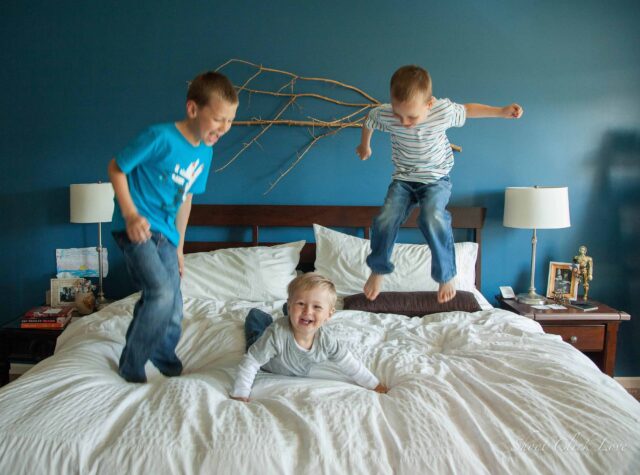
Jumping
- on bed
- couch
- trampoline
Climbing
- rock walls
- jungle gyms
- monkey bars
- ropes
- slides
- through a tunnel
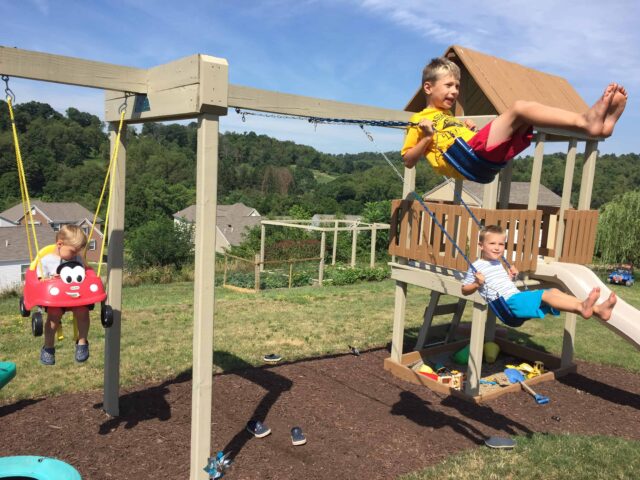
Swinging
- outdoor swings
- indoor swings
- porch swings
- swinging child in a blanket
Riding
- scooter board
- bikes
- scooters
- skateboard
- roller blades
- sleds
- any of the above over bumps or down hills
- seesaw
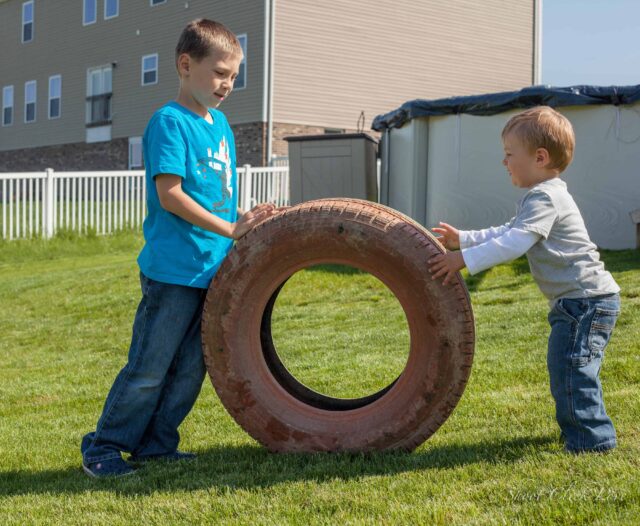
Pushing/Pulling Heavy Objects (Heavy Work Activities)
- carrying groceries
- pushing empty garbage cans inside
- raking leaves
- pulling weeds
- shoveling snow
- vacuuming
- pushing grocery cart
- carrying a laundry basket
- a rope tied to a door knob or heavy object (see image at top)
Chewing
- crunchy foods
- gum
- salty or spicy foods
- chewy jewelry
- chewable pencil tops
- chewable safe toys
Vibration (is alerting versus calming when used in short bursts)
Playing active games
- running
- obstacle courses
- skipping
- leap frog
- tug of war
- wheelbarrow walking
- various animal walks (walking like a crab, hopping like a kangaroo, etc.)
- row, row, row your boat with a partner
Drinking something cold
Swimming
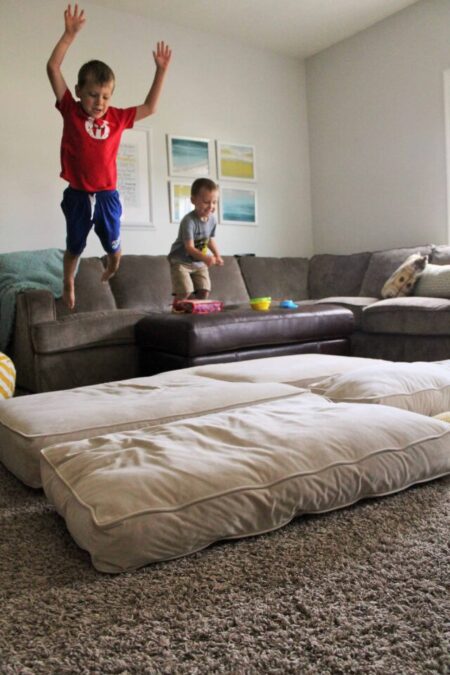
Crashing and jumping into pillows (put all of your pillows or stuffed animals in a pile on the floor)
Playing with textures (Stimulates the tactile sense)
- shaving cream
- finger Paint
- mud
- wet sand
- water
- ice
Blowing
- various whistles and noise makers
- bubbles
- pinwheels

Rolling on a large ball on back or belly
Sitting on a large ball
- during meals
- for homework/in school
Scratching their back vigorously for a few minutes
Spinning (***a very intense sensory experience, best for kids to spin themselves even if they love spinning. Be very cautious of spinning a child, and only do so a few times in both directions. This is important because it will help balance out their system.)
- swing
- swivel chair
- while standing
- sit and spin
Sensory Activities That Are Calming
Wearing Tight Clothing
- Body socks or stretchy bands for short intervals during play
- Compression clothing worn throughout the day
Wearing compression or weighted vests for 10-20 minutes during difficult times of the day (i.e. transitions)
Quiet time in sensory tent
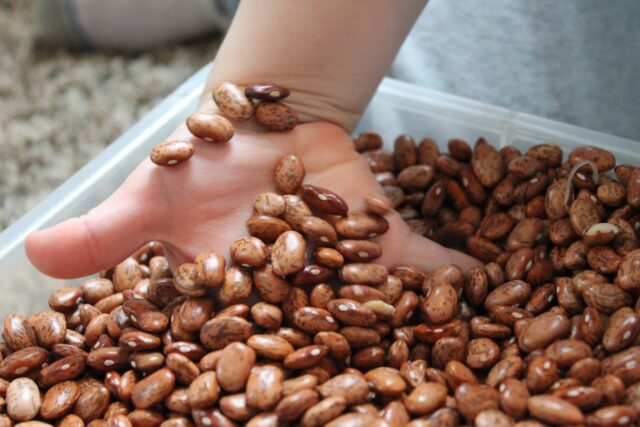
Playing in sensory bin (tons of ideas, the sky is the limit)
- rice
- beans
- birdseed
- sand
- cloud dough
- noodles
Massage
Kneading playdough or therapy putty

Handling fidget toys (a wide variety of options)
- koosh balls
- stress balls (my son’s homemade version is in the pic above)
Squishing and squeezing
- hugs
- squeezing into tight spots or behind furniture
- wrapping up tightly in blanket
- sleeping in stretchy sheets that are tucked in on sides
- laying under a large yoga ball
Sit or stand or a wobble cushion or wiggle seat (great for meals, homework, and crafts)
Using essential oils (different types of oils are used to calm or be alert, check out this get start guide)
- in room diffusers
- applying to skin
- in bath
Listening to rhythmic or soft music
Wearing noise cancelling headphones
Watching slow moving or soothing images
- Fish tank
- Lava lamp
- Slow changing lights
Drinking something warm
Sucking on a piece of hard candy or a lozenge
Slow rocking
- Rocking chair
- Hammock
- Glider
Using heavy or weighed blankets or lap pads (check out the whole guide for weighted blankets here and how and when to use weighted lap pads.)
Sensory Activities for Toddlers
If you’ve got a younger child at home, many of these activities will work. But if you’re needing age-specific ideas for your little one, check out this post on sensory activities for toddlers.
Now that you have this huge list of sensory diet ideas, what’s next?
How do you know which activities to use with your child and when? How often should you do them?
Those are all very important questions, and to answer all of those, you’ll want to grab a seat in the my new free workshop: Expert Secrets to Calm + Focus Your Child with Specialized Sensory Activities
As an OT, sensory is one of my specialties, in the workshop, we’ll be giving you our expert know-how with the practicality of real-life mom.
This sensory stuff can get overwhelming pretty fast, and for good reason, in the workshop, we’re going to be putting an end to that!
More Sensory Diet Activities
Powerful Proprioceptive Activities that Calm, Focus, & Alert
Everything Oral Sensory: The Total Guide
Sensory Strategies for Wild Kids
13 Easy Sensory Strategies for the Classroom
Did You Pin This?
Alisha Grogan is a licensed occupational therapist and founder of Your Kid’s Table. She has over 18 years experience with expertise in sensory processing and feeding development in babies, toddlers, and children. Alisha also has 3 boys of her own at home. Learn more about her here.

Hello! My daughter is 5 and walks on her toes though she has no other diagnosis. What would be a toe-walking sensory diet?
Hi Lauren! Thanks for reaching out! Toe-walking is related to proprioception, therefore, any of these proprioceptive activities would be helpful 🙂
Best,
Kalyn
Hi Alisha,
What would you suggest for an 11-year old boy who loves wrestling? Whilst I don’t have any issue with him wrestling per se, the problem is that he likes wrestling with his 8 year old sister who is much lighter and a slimmer build than him. She does enjoy it – most of the time – and they try and do the moves without hurting each other, but accidents are inevitable and my wife and I worry about them when we’re not there to keep an eye on them. Can you think of any activity that would satiate his body’s desire for such rough play?
Unfortunately, there aren’t any wrestling clubs in our area, and he doesn’t want to join a boxing or martial arts class. Any advice would be much appreciated!
Hi Stuart! Thanks for reaching out! We have a blog post that lists a bunch of different activities that may be great substitutes for wrestling and can help satisfy that sensory need. Check it out here!
Best,
Kalyn
Hi! My son is 14 and has terrible eating habits. I don’t know how to help him. He eats very few things and says he doesn’t like food. Any suggestions?
Hey Robin,
That can be really challenging! A lot of our suggestions on the site can be adapted for older kiddos and teens. HERE is an article that gives you some more suggestions in helping teens. Please reach out with any questions 🙂
Best,
Andrea
Good evening Alisha,
I was just wondering I have a 4 year old kid who likes to put non edible objects in his mouth. I was wondering what are your thoughts on using Chewy Tubes or Chewlery for managing that behavior? I know there are many available but are you able recommend some? Also whenever he has tantrums his mother gives him cereals that appear to calm him down.
Hey Genia,
Yes, there are so many great chewy tubes and toys out right now! They are great alternatives to give kiddos the oral sensory input they’re craving in a safe way. Another suggestion we have is to start using a vibrating toothbrush. That increases the sensory input and often helps give them what they need as well 🙂
Best,
Andrea
My kid is a fussy eater . He only eat the food he like and always say whenever we try to introduce new food He also look down and walks around in circle . We have no issue with dressing up , brushing his teeth . He love jumping , riding bike running around . Everything else is ok .
Can you please advise if fussy eating and walking around for no reason is sensory thing and how to fix it .
Hey! Thanks for reaching out to us! There is a strong connection with sensory and picky eating. It could be a sensory reaction or also showing him being anxious with the new foods that he hasn’t eaten. You can save your spot in our free picky eating video series where we will walk you through where to start with your picky eater and how to address it. Save your spot HERE
Best,
Desiree
My 4 year old daughter will never sit or stand without moving. She is always moving and sometimes i have to hold her to keep her still. She will never sit in one go to finish her food. Always running around. And she is a very picky eater and afraid to try new foods. her attention span is a hugeee issue
Thanks for reaching out! I’d make sure to be allowing her to get some proprioceptive input prior to meals to try and help calm her for increasing sitting length. You can also look into a Wobble Cushion so that she can get some movement while sitting. If you are looking for tips for the picky eating side we are currently running our free picky eating video series you can save your spot HERE
Best,
Desiree
I totally forgot to mention that he is severely speech delayed and we are waiting for our appointment with speech pathologist.
It can be normal for kids to refuse teeth brushing at this age. There is obviously a sensory component. Check out this post on Oral Aversion, I think it will be helpful!
Hello Alisha.
I have 2 years and 3 month old son who is very reluctant to brush his teeth. We have tried every trick out there but no success. His eating is fine. But very hyper active, always whining and poor sleep.
Sometimes I go over the top and loose it. But I want to help him and myself.
Can you please suggest anything which could help him and us.
Hi, i loved the list. My 7 years old daughter is struggling with clothing issues especially underwears and leggings. She won’t wear all kinds of underwears and leggings and its hard to tell which ones she would like. While sleeping if her blanket is not properly fixed, she will start crying. She doesn’t like to wear jeans or any pants which has buttons, so mostly she wears leggings, bike shorts, skirts, etc. She is struggling with all this since 3 years old. Some days she is good with her clothes, some days its a pain for her. She is very active, smart and manages well at school. She goes for swimming, gymnastics, skating, piano, etc. From your OT experience, could you suggest what activities will be good for her?
I’m so glad and I actually have a full post dedicated to clothing sensitivities that I think would be really helpful. And, to be honest, if I were her OT, I’d be taking a step back to regulate her sensory system overall- on the days she needs it. That’s why she’s having some good days and some not, because the sensory system is always changing. Lots can affect this: sleep, diet, if she’s had other calming/organizing input. Some of the activities on this list could be a help to her even though they aren’t directly related to her clothing. I’d start experimenting and see what helps- she’ll also be able to tell you! Did you see the free sensory workshop? I think it will be extremely helpful!
This is awesome! THx you for the ideas. How do I know which sensory diet to use for daughter to benefit her needs? For example some days she’s sucking on her shirt, another day she cant sit right on the couch. Did I miss that part?
It can change from day to day. I like to have several activities that could work, which does take some trial and error. Have you seen the free sensory diet workshop? It teaches you how to design a sensory diet, I think it will be VERY helpful.
Hii Alisha my child becomes overwhelmed when he sees bright lights and flashy lights of any celebration or functions takes places in my family . He becomes uncontrollable what should I do??
I’d keep a pair of sunglasses with you and if you can prepare him in advance. Teach him how to close his eyes tight and turn into you. Let him know that you understand and will help him!
Are you an occupational therapist?
Yes!
Do you have any recommendations for an almost 4 year old boy who is not interested in potty training despite using every method out there. He reportedly “likes the feeling of a warm, wet diaper” and doesn’t want to change except maybe 1x/day.
That’s tricky. If it were me, I’d pick a couple of days when I could handle it and put him in underwear. I’d also just start sitting him on the toilet at regular intervals. He may like a wet diaper, but wet underwear is a whole other situation.
Hi how to deal with delay milestones n his speech
From a sensory standpoint, I’d try certain activities on this list and see if any help him verbalize more- I’ve seen this many times! Jumping on the couch or a large ball are a good place to start!
Hi
My kid is gaging if he sees something that he already chewed, or something smashed foods , he even vomits so easily.now he has started even if I cough he is gaging, or if I wipe my nose with a tissue. Recently he could not see my teeth and felt to gag but it happens only sometimes.he doesn’t like to eat foods.only like to drink milk.he is very active kid, he goes to tantrums so easily for example he like to feed the fish in fish tanks , and if I forget to ask and give him to feed, if he saw that he goes so big tantrum and even I said oh I am sorry but you can feed the rest and I give some fish foods to him it doesn’t matter, he wants me to undone it, like I should collect every food I put in the tank , and he should repeat it. Alot of things like that he wants me to reverse it, it’s like if I put on a switch on a lamp then he wants me to shut it, and then he put on back , I tried to show him drinking from a glass and now I drank it and I can’t undone it , but I don’t know it’s difficult to explain to him ,
Hi Ruhashinee,
It sounds like there is some sensory dysregulation going on here with your child based on what you said. Have you taken our free sensory workshop? It is a great starting point for understanding some of this behavior in order to address it and help him improve his regulation. You can save a spot here and watch at your convenience.
Best,
Laura
Your Kid’s Table team member
I am new to this. We just had an evaluation done but I am waiting for the official report. The OT said he’s going to need a proprioceptive sensory diet. We go to a music class once a week and my son gets crazy there, he loves the class but runs around like crazy disturbing the class. He’s loud on top of it which only makes it worse. My friend who is a special ed teacher said to do a quick two minute thing right out in the parking lot before going in. She said something about doing movement, then lifting or pulling and then big bear hug. Any suggestions of what I can do in a crowded parking lot?
I know it can be really overwhelming Krissy and this list all sorts of activities, although a lot of proprioceptive activities. I’d really recommend looking at what is a sensory diet and the sensory diet template, too! For crowded parking lots, using a nice firm grasp around their wrist is great. Also, giving them something with some weight to carry, or even a little book bag with weight. The thing with sensory diets is that they are totally unique to each child, so while some activities generally work they don’t always. Does that make sense? You’ll want to experiment and also try a few times, as well. Doing calming activities before leaving the house (jumping on bed, running, swinging, etc.) can also be helpful.
I just wanted to comment and let you know how much your blog has helped me.
My son (2.5 yo) was a great eater but after moving to a new country and living with my in-laws for three months he became a terrible eater.
Part of it was that my MIL and FIL kept on giving him an out. If he didn’t eat what was on the table, he’d get rye bread and butter after dinner.
Part of it was me giving up and not fighting more for what I wanted. I just didn’t want to fight any more…
After we moved into our own home, my son became very defiant. Refusing to eat what was on the table. Asking for bread as soon as he sat down to eat. We were fighting every night.
I was dreading meal times. It wasn’t that he doesn’t eat veggies or fruit (he loves them). Give him some raw veggies for a snack and he’s all over them!
After begging, getting angry, trying to make him what he wants, I started reading online.
I found your blog and stayed up until 4 am in the morning reading various blog posts.
It helped SO much.
I no longer beg him to eat. I no longer show an interest in how much he’s eating. I no longer use dessert as an incentive. I just speak about the food.
We’ve always had the “you can eat whatever and as much as you want” of whatever you want on the table.
However, if he didn’t want to eat at all, he was allowed to leave the table. We brought toys to the table to keep him entertained. We sometimes caved and let him watch tv while eating… just so that he could get a few bites in .
Now?
He has to sit at the table with us even if he doesn’t eat.
He pours his own food. As much or as little as he likes.
No toys or tv. Full stop.
You have CHANGED our meal times!
We no longer fight. We no longer argue. Meal times are now just a meal time.
Even when he says he doesn’t want to eat, once he realises he cannot leave the table, he tries the food – generally, likes it – and eats.
Your non-judgemental, loving and caring attitude made the no-nonsense attitude so much easier to take in.
As soon as I can afford to – I will be purchasing your Meal Works course. I am sure there is a lot more I can benefit from knowing!
Oh my gosh Jo, this is one of the best things I’ve ever read. I’m sorry its taken me so long to respond, know that when I saw this it completely made my day!!! You have worked so hard and made really big changes that aren’t easy. Pat yourself on the back because that is no small feat. Your story is so powerful and it will really help motivate and inspire others that are reading it!
It’s absolutely Okay! Just so you know, that meal times are still going strong.
My husband still slips up a bit and says “How about one more bite?” … lol! I usually scold him softly in English (our kiddo is bilingual [we haven’t worked on English with him just yet], he will be trilingual with English) and let our son make his own decision on how much he eats.
My mom has been on Skype with us a few dinners (the only exception to no computer/tv) just because I wanted to show her how well he’s eating!
She was super impressed.
Thank you, I’m not recommending your site to whomever I see is in need!
not = now.
Thank you, I’m NOW recommending your site to whomever I see is in need!
Aww that’s wonderful Jo! Yay!!! Thanks so much for the update and sharing the info! I love hearing this:)